

'Schild en Vriend' is an old Flemish battlecry, used in the rebellion of the city of Brugge against the French, May 18, 1302. Legend tells that it was used to differentiate between the French-speaking (who could not pronounce 'schild') and Flemish-speaking citizens. Nowadays, historians tell us that it was probably 'Des Gilden Vriend'.

This was fictional a 20mm WWII battle fought between Russian and German forces, set in March 1945. Rules used were Rapid Fire, and most figures were provided by umpire Frank, who also came up with the scenario. Players were Phil, myself and new faces Alan Huyton and Bart van Bael as the Russian commanders, whilst Bart D. and David took care of the German troops. The game was played to conclusion in somewhat over three hours and great fun was had by all and sundry.
If you find certain similarities between this page and the excellent battle reports on the Major General Tremording Rederring's site, rest assured that they are all highly intentional. After all, the best (and most useful, by the way) form of flattery is imitation (-:.
The terrain layout
| The game was played on a 3 meters by 2 meters table (that's approximately 9'x6' for you imperial types). A railway line ran along the southern edge, splitting off a side track just outside of the village of Gross-Untendorf. The village itself took up the southern central portion of the board and consisted of your typical crossroads with more or less destroyed buildings scattered about. The rest of the board consisted of fields, two or three large woods and a swamp along the north-western edge (not visible on picture). Smaller copses of wood and brush were dotted around the remainder of the board. | 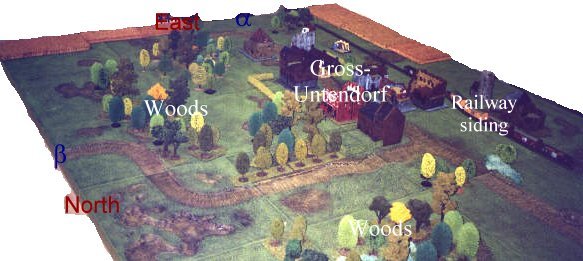
|
It is March 1945, the final Russian offensives are in full swing, and German forces are retreating everywhere. Near the village of Gross-Untendorf, the commander of a smallish Russian rifle regiment stashes away his binoculars and gives his men the order to advance to clear yet another in an endless string of German hamlets.
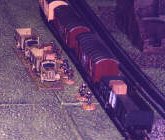 Unknown to the Russian commander however, was the fact that the German commander had no intention whatsoever of defending this village just on principles alone. In fact, the only reason he and his force were still in Gross-Untendorf and not already high-tailing it westwards towards schnapps, bratwurst, and more importantly, the Americans, was that his higher commander ummm... acquired some paintings and other art treasures during the war, and was quite keen on saving them from paws of the Russians, who probably did not appreciate fine art anyway. The art treasures rolled into Gross-Untendorf by train just in front of the advancing Russian forces and would have made it to safety, had the Russian air force not held some target practice in and around Gross-Untendorf the day before, resulting - apart from a drastic redecorating of the entire town - in two destroyed Tiger tanks in the village and a bloody big hole where the railway track used to be just outside of town. Undaunted, the German commander booted his infantry out of their trucks and started unloading the precious art treasures - including the infamous painting of the Fallen Madonna with the big boobies [*] - onto the trucks. Unfortunately, just as his troops started packing away the booty, growling engines and booming cannons anounced the arrival of the Russian bear in the village...
Unknown to the Russian commander however, was the fact that the German commander had no intention whatsoever of defending this village just on principles alone. In fact, the only reason he and his force were still in Gross-Untendorf and not already high-tailing it westwards towards schnapps, bratwurst, and more importantly, the Americans, was that his higher commander ummm... acquired some paintings and other art treasures during the war, and was quite keen on saving them from paws of the Russians, who probably did not appreciate fine art anyway. The art treasures rolled into Gross-Untendorf by train just in front of the advancing Russian forces and would have made it to safety, had the Russian air force not held some target practice in and around Gross-Untendorf the day before, resulting - apart from a drastic redecorating of the entire town - in two destroyed Tiger tanks in the village and a bloody big hole where the railway track used to be just outside of town. Undaunted, the German commander booted his infantry out of their trucks and started unloading the precious art treasures - including the infamous painting of the Fallen Madonna with the big boobies [*] - onto the trucks. Unfortunately, just as his troops started packing away the booty, growling engines and booming cannons anounced the arrival of the Russian bear in the village...
In the game, the Russian commander had a basic 'search and destroy' mission, while the German commander had to buy time by defending the village to get as much of the art treasures as possible loaded onto the trucks and transported off the board to the west. This German victory condition was unknown to the Russian players.
|
[*] For those of you wondering, the "Fallen Madonna with the big boobies" was a painting that featured quite prominently in the British comedy series 'Allo 'Allo. During the course of the series, it changed hands more often and more quickly than you could say 'Fallen Madonna etc.', and even suffered the ultimate deprivation of having one of the infamous boobies cut out to prove the painting's authenticity. But I digress... (-: |
Russian forces
The Russians had a smallish rifle regiment consisting of only two battalions, but were reinforced by a considerable amount of armour. The first rifle battalion consisting of three rifle companies and a support company with mortars and a medium machine gun, was completely mechanised with lend-lease M3 half tracks. They also had armour support in the form of one KV-II infantry tank and a SU-100 assault gun.
The second rifle battalion had lost it's support company somewhere further to the east (rumours had it that the convent passed the day before had a well stocked wine cellar, and the support company's troops had volunteered to investigate...), so consisted of three rifle companies and HQ only, but this was compensated by the fact that they were borne into battle on two T34/85, a T34/76 and a JS-II, a motley collection of tanks if ever there was one.
Russian forces could enter the board at the points marked alfa and beta on the view above.
German forces
The German forces scratched together to hold up the Russian bear in the village of Gross-Untendorf consisted of the remainder of an elite rifle regiment, consolidated into three rifle companies with an HMG and two Panzerschrecks between them. Armour support consisted of two Panther tanks, a Hetzer panzerjager and a PzII Lynx recon tank.
The Germans also had artillery support in the form of two batteries of 105mm howitzers, with forward observers mounted in, respectively on, a Kubelwagen and a horse, while an 88mm flak gun sited to defend the village against air attacks, was promptly pressed into a ground role.
Last but not least, there was a single company of infantry arriving by train, responsible for unloading the paintings onto waiting trucks.
German forces were allowed to set up anywhere inside and to the west of the village of Gross-Untendorf, and were hidden until spotted (using a counter based system).
The battle
The Russians, realizing that frolicking around a village possibly full of trigger happy German infantry would not look good on their tank commanders' resumés, wisely opt to send in the tanks along the northern road. Snobbish as they are, the tankers immediately dump their infantry along the edge of the woods and start down the road towards the exit of Gross-Untendorf, although one T-34 quickly opts for the sneaky approach through the woods and another one starts a wide sweep towards the west. On the eastern side of the village, the halftrack-borne Russian battalion dismounts and prepares for a heavy frontal attack through the village.
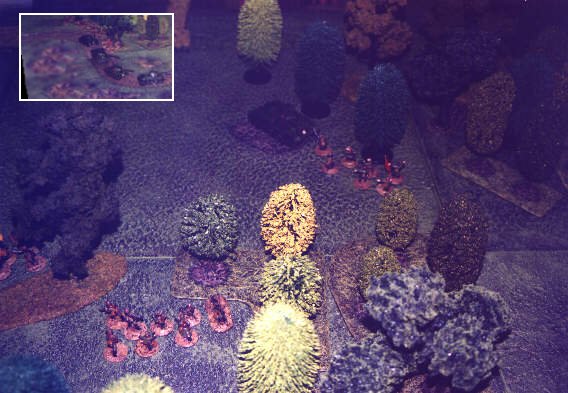
| North of the village, the Russian infantry, after dismounting from the tanks carrying them, foot-slog their way through the woods towards Gross-Untendorf. One T-34 takes pity on them and accompanies their advance for a short while.
Inset picture - After dropping their accompanying infantry, Russian armour starts its advance along the northern road. |
The initial German response is short but painful (to the Russians, that is). A Panther, parked among the easternmost houses (ruins, actually) turns its turret, takes careful aim and takes out the SU-100 supporting the infantry with a single well-aimed shot, while a Hetzer parked next to it's bigger brother, stops a Russian lend lease M3 halftrack in its' tracks - quite literally, as the halftrack was zooming up along the railway track. This tankfire mayhem scares the remaining Russian armour on this side of the board so much that the KVII and one halftrack decide they must have left something back at the start line, and execute an accelerated retrograde movement (read: run for their lives).
The Russian infantry, seeing their supporting armour (and with it, their virtually only way to take out the pillbox on the edge of the village without actually assaulting it) disappear back out of sight, wisely opt to choose safety above bravery and scatter for the closest cover.
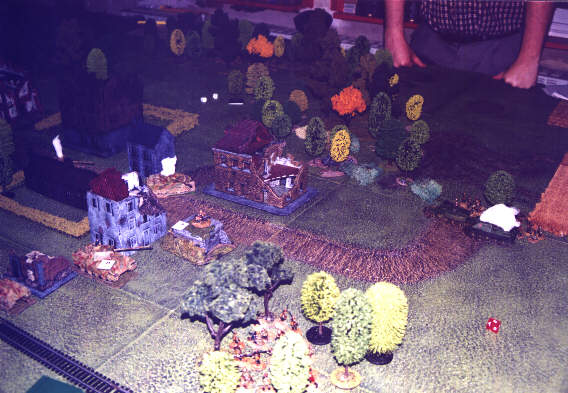
| The SU-100 lies smoking on the road, while the Panther responsible for its' destruction sits menacingly to the left of the house. Other Russian armour has either made itself scarce or is frantically trying to avoid fire. Russian infantry, being the sensible blokes they are, are hidden in the woods in the foreground and behind the wreck in the background. |
Meanwhile, on the road to the north west of Gross-Untendorf, after shrugging off the effects of (indirect) fire from a pair of 105mm howitzer batteries, two of the Russian tanks (a T34-85 and a JSII) suddenly come under fire from an 88mm flak gun cunningly hidden in a whopping big bunker complex situated on the crossroads. To make things even worse, another Panther suddenly emerges from behind the corner of a house and immediately adds the weight of its' own fire to that of the 88mm. Things look grim for the Russian armour...
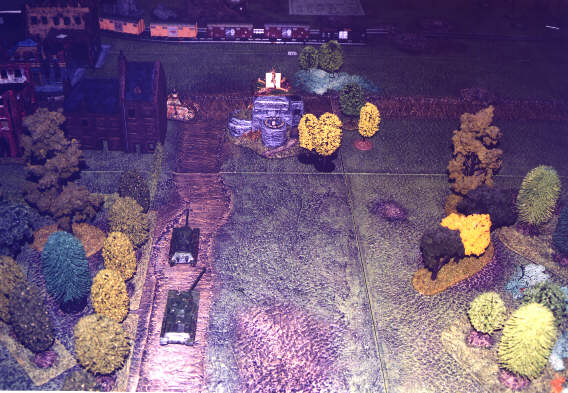
| A T34 and JSII advance along the road to the train station. German opposition consists of an 88mm flak gun located in a bunker on the crossroads and a Panther tank, just visible at the corner of the house across the road from the bunker |
The Russian tanks however, show they are not afraid of a few incoming heavy-caliber anti-tank shells and enthusiastically set about the business of returning fire and showing these German gunners how real men fire a tank gun. A few frantic moments later, Russian marksmanship gets the upper hand and an HE shell is lobbed straight through the firing slit of the bunker, blowing up the unfortunate 88 mm inside. Encouraged by this success, the Russian tankers then make short work of the Panther, and the way to the rail yard lies open.
All this armour action to the north west of the village, prompts the German commanders to pull the Panther on the eastern outskirts of Gross-Untendorf back to the west, thus leading to a claim by Russian infantry of having chased away a Panther tank by the sole means of looking at it in a very menacing way. The same Russian infantry hiding in the woods on the eastern edge of the village, however, starts getting fire from a machinegun in the pillbox guarding the approach to the village, and a German company hidden away in the house behind the pillbox opens up with small arms on the hapless Russians as well. The only reply the Russian infantry was able to give were a few ineffective mortar rounds, so things would have looked very bleak indeed had not a sudden clanking of tracks and roaring of an engine announced the return of the KVII from it's short rearward detour. At last some firepower!
The situation to the west of the village was looking a lot more promising for the Russians. The T34 and JSII that had taken care of the 88mm and Panther burst onto the rail yard, emerging in the middle of a gaggle of German soldiers apparently unloading something from the train onto some trucks. This mystery was quickly moved to the bottom slot of the Russian priority list however, as a torrent of small arms fire form the surrounding houses and small caliber AT fire from a little tank (commanded by Lt. Gruber perhaps?) announced the intent of the Germans to keep on fighting.
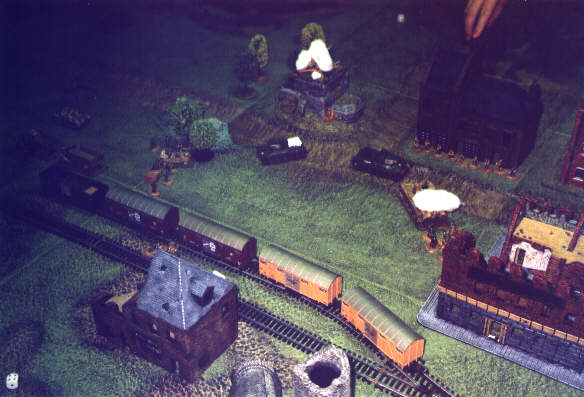
| The T34 and JSII burst into the rail yard, scattering German defenders left and right. Far to the left, two trucks loading the art treasures can be dimly made out through the battlefield gloom. The large bunker on the crossroads and the Panther in the foreground are still burning from their encounter with the aforementioned Russian tanks. |
Continue in part 2 of the battle report: the Russians capture the village and the Fallen Madonna with the big boobies!

Home | This page is maintained by Bart Vetters Schild en Vriend Miniature Wargaming Club Leuven |